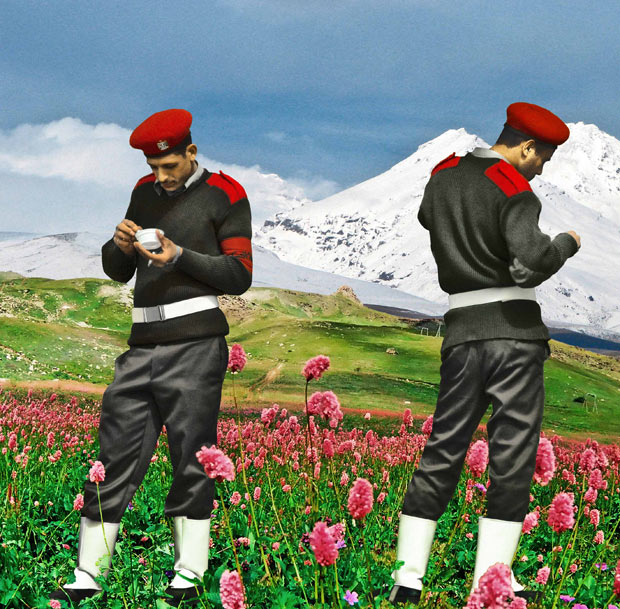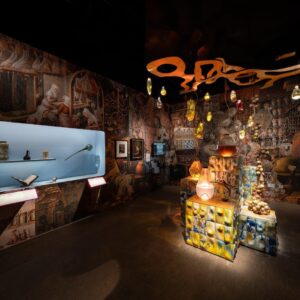
Nermine Hammam’s The Break, from the series Upekkha, 2011. Photograph: V&A
The photograph is sepia. It shows a veiled woman in a 19th-century studio with a backdrop of painted clouds and tasselled curtains. She wears traditional Iranian robes. But she is also wearing Ray-Bans, which she adjusts with a casual hand like some 21st-century starlet advertising shades. It is the very definition of a political gesture.
The picture was taken by Shadi Ghadirian, who lives and works in Tehran. She has made many others: veiled women with their faces concealed by rubber gloves or saucepans, veiled women posing with the bicycles they cannot easily ride. But this one turns on photography itself, on the history of studio portraits in Iran. Her subject is in a tight spot: not as free as the women who posed long ago in front of that cosmopolitan backdrop, perhaps, and yet sitting here in dark glasses. To which time does she belong, in this photograph of two eras?
Light from the Middle East is full of startling images – Beirut in happier days, Yemeni sailors living in South Shields, Egyptian soldiers from Tahrir Square transplanted to what looks like the Alps. Some have clearly passed through the creative process of collage, hand-tint, double exposure, Photoshop and so on. The curators are eager to stress the aesthetics involved.
And indeed there are Cibachrome prints the size of posters, archaised Polaroids, lightbox images and stunning photographs (by Tal Shochat) of pomegranate trees glowing jewel-bright by night that look more like medieval tapestries than shots of Israeli orchards. But on the whole this show, and its many insights, are emphatically political.
How could they not be? Presumably there are Middle Eastern artists still taking photographs of the sunrise over Mount Sinai (though that too might have its pointed significance). But the 30 photographers represented here are skimming images from their life and times, from the streets and society around them. The show opens with the deathless shots of Magnum photographer Abbas documenting the unfolding revolution in Iran from 1978-1979, and it ends with Tahrir Square.
Mehraneh Atashi’s photograph of a bodybuilder working out in an Iranian gymnasium counts as a self-portrait of sorts in that she is there too – where she presumably shouldn’t be – as a tiny reflection in a mirror surrounded by the wall-to-wall images of ayatollahs. The artist is, of course, heavily veiled.
Joana Hadjithomas and Khalil Joreige have found a way of treating old negatives of Beirut in the glory days before the civil war – the elegant hotels, the water-ski centre – so that these picture-perfect postcard vistas appear to be burning up before your eyes. It is an extraordinarily peculiar effect, something like melting celluloid.
The mothers of martyrs hold up photographs of their sons, forever young, while the women are sorrowfully aged. Girls in full black hijab are learning how to fire rifles. A close-up of a fighter’s torso, heavily girded with ordnance, grenades, pistols and knives, glinting in the desert sun, makes the face of Bryan Adams on his ragged sweatshirt pale into insignificance. Weapons aplenty, but barely anything to wear.
The photographs bring back news from elsewhere in torrential detail. Shots of an underground party in Bahrain show wine glasses among the dishes of machboos and falafel. The dancers’ faces, hands and necks have been Tipp-Exed to protect their identities, so that they also look – succinct device – as if officially censored.
The exact meaning of an image isn’t always obvious, or at least not to my western eyes. I don’t know what the slate she is holding says in Arabic, but the English title of Manal al-Dowayan’s portrait of a dark-eyed, bejewelled woman – I Am an Educator – feels like some kind of post-Edward Said jab against western Orientalism.
Abdulnasser Gharem‘s The Path, on the other hand, may be covered in Arabic script – white characters stretching into the distance like scattered snowfall – but the kerb is blood-red with slogans. Death is written on this Saudi wayside.
Not all the images in the show have such power. A series of Sufi parades in Syria cannot catch the whirling, banner-waving mystery of those spectacular rituals. How to photograph a crowd without losing the individual beings, how to photograph individuals without losing the crowd?
That is at least in part the sardonic content of Ahmed Mater‘s epigrammatic black-and-white photograph of a black magnetic cube drawing ring upon concentric ring of iron filings to its Mecca. Only inches away from the image, these atoms look exactly like millions of people.
Mater’s work was shown at the British Museum’s Hajj exhibition earlier this year; and some of these artists are well known in the west. The Moroccan photographer Yto Barrada was Deutsche Bank’s artist of the year in 2011, and had a fine show at the Ikon Gallery in May. Her large C-print, entitled Bricks, shows a balmy landscape undulating into the distance, the hills covered in tiny houses, but with one great heap of bricks in the foreground. Is it about to rise, or return to rubble – is this the end or the beginning of life?
The strongest images here fuse the politics with the aesthetics to profound effect. The Yemeni sailors in their turbans and toques look like kings of the past, each in the little kingdom of his carte-de-visite, hand-tinted in fading violet and primrose. Ancient faces still visible in contemporary South Shields, they are the descendants of those who first arrived a century ago.
Sharpest of all is a photograph that reflects upon the peculiar dominance – and danger – of mechanical reproduction itself. Tehran 2006 is a vast image by Mitra Tabrizian. It shows dark-clad and downtrodden citizens at a distance, trudging wearily in circles round the suburban wasteland. The Ayatollah Khomeini stares pitilessly down from his billboard, perfectly reproduced at about 10 times the size of the bleak human lives below.
guardian.co.uk © Guardian News & Media Limited 2010
Published via the Guardian News Feed plugin for WordPress.









